2. Vehicle Measurement, Control and Safety Key Laboratory of Sichuan Province, Chengdu 610039, China;
3. Provincial Engineering Research Center for New Energy Vehicle Intelligent Control and Simulation Test Technology of Sichuan, Chengdu 610039, China
China's oil dependency on international oil market has already broken through 73%. The fossil oil consumption on engine has reached more than half of the total oil consumption in China, especially in great demand for diesel. In 2020, 204 million tons of diesel fuel and 111 million tons of gasoline fuel was used in China. China is a large agricultural country with vast rural area. The small diesel engine is the main power for the agricultural and plant protection machinery in the countryside. Fig. 1 shows the production of tractors in China from 2011 to 2019[1]. It can be seen that small tractors are important parts of Chinese tractors. Mostly, the single cylinder small diesel engine is used in the small tractor. Small diesel engine dose brings convenience to the agriculture, but also causes the problem of environmental pollution. Particulate, sulfur compounds, and nitrogen oxides are the emission of diesel engine, and also the main components of smog. In particular, the particulate with small particle size and low sedimentation rate can suspend in the atmosphere for a long time[2], causing serious hazard on human health. Compared with city vehicles, Chinese emission regulation standard for agricultural diesel engine is quite loose. Chinese non-road diesel emission standard was implemented in October 2007, much later than America which was started from 1996. Table 1 and Table 2 show the current emission standards of non-road diesel engine in China and European Union. As can be seen, the emission standard of non-road diesel engine in European Union is stricter than in China, especially the emission limits for PM (particulate matter) and PN (particulate number). Since the urban traffic vehicle emissions have been attached much importance, the emissions on agricultural diesel engine should also be given enough attention. As a result, considering China's national conditions, it is necessary to strengthen research on emissions pollutant of small agricultural diesel engine.
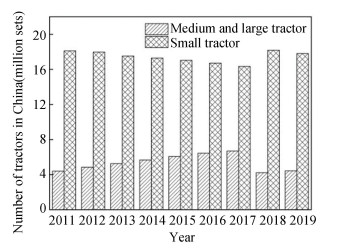
|
Fig.1 The number of tractors in China from 2011 to 2019 |
| Table 1 Emission standards of non-road diesel engine (China Tier 3) |
| Table 2 Emission standards of non-road diesel engine (EU Tier 5) |
To solve the problem of energy shortage and environmental pollution, many Chinese researchers have done much work on the alternative fuels for diesel. Methanol and biodiesel are oxygenated alternative fuels of diesel engine. China is rich in coal but lacking in oil. Methanol is mainly made from coal, with simple chemical production process and low cost in China. So the methanol has a high production. In 2016, the proven coal reserve was 249.23 billion tons, and oil reserve was 3.50 billion tons[3]. At present, China has become the biggest producer of methanol in the world, but the high methanol production has not been well used. As of April 2021, China's methanol production capacity is about 101.54 million tons per year, accounting for 74% of the global total capacity. However, the production of methanol in China was only 68.7 million tons in 2020[3]. A considerable part of the coal is used for electricity generation in China. Study has shown that, the average thermal efficiency of coal for electricity generation is only about 30%[4], while the thermal efficiency of coal-based methanol in an internal combustion engine can reach 70%-80%, with lower emissions[5-7]. Biodiesel is a kind of renewable alternative energy of diesel engine. Biodiesel is made from oil by esterification reaction. Wang et al.[8] carried out the reliability test of diesel engine fuelled with B5 biodiesel. Results showed that B5 can be used directly in diesel engine without any adjustment, and the engine performance has little change. The study of Özener et al.[9] showed that when biodiesel is used in diesel engine, the emission can be reduced. Sathiyamoorthi et al.[10-12] studied the performance and the emissions of diesel engine fuelled with the biodiesel, neat lemongrass oil with antioxidant additives. Results showed that, biodiesel has good effect on emission reduction. Moreover, the addition of antioxidant additives in neat lemongrass oil-diesel blend showed maximum NOx reduction to 11%. Therefore, biodiesel has received extensive attention and become a research hotspot[13-15]. In recent years, Chinese government also pays great attention to the development of biodiesel. In 2006, China Renewable Energy Law was promulgated, which clearly required the oil market to put biological liquid fuel meeting the national standard into the fossil fuel sale system. In 2007, the first biodiesel standard (GB/T 20828-2007) of BD100 in China was promulgated, and this standard greatly promoted the standardization of biodiesel industry. In 2010, the biodiesel standard (GB/T 25199-2010) of B5 was also promulgated, and this standard brings biodiesel to the oil market. The analysis above shows that methanol and biodiesel could achieve the purpose of fossil fuels saving and emissions pollutant reduction. Considering the Chinese condition of energy and national policy, methanol and biodiesel are promising substitutes for diesel fuel.
As the properties of methanol is quite different from diesel, there are generally two ways of using methanol in diesel engine: emulsification[16-17] and electronically controlled injection[18-20]. The electronically controlled injection can achieve a large proportion blend of methanol, but the engine needs to be installed with methanol supply and control systems, which are structurally complex and has high cost. Thus, this way is mainly used in automotive diesel engines. The emulsification only needs to mix methanol and biodiesel into uniform emulsion before injecting into the combustion chamber. What is more, methanol and biodiesel are easily dissolved without adding any cosolvent, and no changes of the engine structure needs to be made, thus the cost can be saved. The small agricultural diesel engine in China is mainly single-cylinder diesel engine. Venu and Madhavan's study[21] showed that when methanol was added, the combustion duration and cylinder pressure were increased, and NOx, PM and smoke were reduced. As the methanol properties were quite different from diesel, the blending ratio of methanol had a great impact on the blend properties. As the latent heat of vaporization of methanol was much higher than that of biodiesel, the combustion temperature of diesel engine fueled with methanol/biodiesel blend was lower, and soot and NOx emissions were less than diesel[22]. The study of Žaglinskis et al.[23] showed that 10% methanol in biodiesel has the maximum reduction of 13% CO and the maximum reduction of 45% soot. Thus considering the factors of ease use and cost-saving, emulsification is more suitable for the application in the small agricultural diesel engine. The methanol/biodiesel blend is in line with China's actual condition of carbon peak and carbon neutralization, and could ease the pressure on energy and environment. Therefore, the methanol/biodiesel blend is a good choice for small agricultural diesel engine.
The above analysis shows that methanol and biodiesel have good solubility, and the application of methanol/biodiesel blend has good effect of emission reduction. As methanol and diesel show great differences on characteristics, adding appropriate improver into methanol/biodiesel blend can improve the characteristics of the blend effectively. However, there are few studies on the effect of engine performance using methanol/biodiesel with additives. Therefore, it is of great significance to analyze the characteristics of methanol/biodiesel blend, and study the effect of the blend with improver on the performance of small agricultural diesel engine.
In order to study the influence of methanol and biodiesel on the power performance, economy and emissions of diesel engine for small agricultural diesel engine, the characteristics of methanol and biodiesel were investigated, and the influence of fuel characteristics on the mixing ratio of methanol and biodiesel was discussed. The effects of methanol blending ratio and cetane number improver on the performance of engine were studied by bench test.
1 Biodiesel Preparation 1.1 Physical-Chemical Properties of the FuelsMethanol is a kind of alcohol with the simplest chemical structure. The biodiesel is made from waste oil by transesterification. The biodiesel and methanol are provided by local companies in China. The methanol purity of is 99.9%. Table 3 lists the physical-chemical properties of 0# diesel, methanol and biodiesel.Refer to Ref. [24] for the chemical formula, carbon content, hydrogen content, oxygen content, and refer to Ref. [25] for LHV. The values of density, viscosity, surface tension, cetane number, autoignition temperature, boiling point, flash point, solidifying point are based on ASTM D891-09, ASTM D2196-2010, ASTM D1331-2011, ASTM D613-2018, ASTM E659-2013, ASTM D1120-1994, ASTM D1310-2001, and ASTM D2500-2011 test method. The heat of vaporization is based on the test method of differential scanning calorimetry.
| Table 3 Physical-chemical properties of 0# diesel, methanol and biodiesel |
It can be seen that the density, viscosity and cetane number of biodiesel are close to diesel. Studies show that when biodiesel was used in diesel engine, the engine power, economy and emission change little[13-14]. Table 3 also indicates that the properties of methanol are quite different from diesel, mainly in oxygen content, heat of vaporization, cetane number, LHV and viscosity.
1.1.1 Cetane numberCetane number is an important index to evaluate the ignition characteristics of fuel. The value of cetane number relates to the molecular structure of the fuel. The longer carbon chain of the fuel results in higher cetane number, while the aromatics or unsaturated hydrocarbons result in lower cetane number[26]. The fuel with higher cetane number is easy to ignite and leads to higher cylinder pressure rise rate. Methanol has shorter carbon chain, leading to lower cetane number of 5, much lower than that of diesel. When a large proportion of methanol is added into biodiesel, the cetane number of the blend is heavily reduced, and the maximum cylinder pressure and engine pressure rate are risen remarkably at high load, even leading to rough running[27-30]. Redesigning the combustion chamber, adding an extra spark plug, and increasing the compression ratio of diesel engine are all good ways to improve the self-ignitability of diesel fuel. However, adding cetane number improvers is a simple and easy way.
1.1.2 LHVThe engine efficiency relates to fuel property and combustion process[31]. The oxygen content of methanol is up to 50%, while the carbon content is only 37.5%. The lower carbon-hydrogen ratio of methanol results in lower LHV. Table 1 shows the LHV of biodiesel is slightly lower than that of diesel. With the increase of methanol, the LHV of methanol/biodiesel blend will be reduced significantly. Though methanol has lower LHV, the addition of methanol increases the engine thermal efficiency[32]. This is mainly due to the following three reasons: 1) Methanol is easy to evaporate because of its lower boiling point, which contributes to quick and efficient formation of the combustible mixture; 2) Since the boiling point of methanol is much lower than that of biodiesel, the "micro-explosion" effect improves the atomization and combustion process; 3) The laminar flame propagation speed of methanol is fast, which is beneficial for accelerating the combustion process; 4) The oxygen in methanol improves the oxygen content in oil-rich zone, promoting the complete combustion of fuel. If the engine rotation and fuel supply advanced angle are not changed, the addition of methanol in diesel engine will accelerate burning rate. So the capacity of combustion is enhanced, and the engine thermal efficiency is increased.
1.1.3 ViscosityViscosity reflects the ability of fluid to resist shear force. The viscosity of fuel is related to lubricating property of the fuel supply system and fuel atomization performance[33-34]. Higher viscosity of fuel increases the motion resistance and power loss. Moreover, fuel with higher viscosity results in larger diameter of oil droplets which is uneasy to break, reducing the quality of fuel atomization. However, lower viscosity will increase the mechanical abrasion and fuel leakage in the component. Only adequate lubrication for moving components will ensure the long-term effective and reliable work of the fuel supply system. The viscosity of methanol is only about 1/6 of diesel, which makes methanol atomized and mixed with air easier. Considering the viscosity of methanol and biodiesel, the viscosity of them could be complementary.
1.1.4 Heat of vaporizationThe heat of vaporization of methanol is about four times higher than diesel. Therefore, during the evaporation and mixing process, methanol absorbs more heat and causes cooling effect. Thus, the temperature and vapor pressure are reduced, resulting in higher inflated coefficient of diesel engine. However, the cooling effect will negatively influence the operation of the engine at low speed and light load. Ref. [35] shows that the evaporation amount of methanol is greatly affected by temperature. For example, the evaporation amount of methanol at 7 ℃ is only 1/6 of that at 20℃. When the engine is operated at light load and low speed, the temperature in the cylinder is lower. Therefore, the evaporation amount of methanol is less, and the concentration of combustible mixture is not easy to reach the limit of ignition, resulting in cold start problems. On the other hand, methanol is easier to evaporate than biodiesel. The addition of methanol can accelerate the evaporation of the mixed fuel. Thus, the spray characteristics will be improved[36].
1.1.5 Blending ratioThe blending ratio of methanol/biodiesel is mainly subject to the following three aspects: blend stability, cetane number and heat value. The miscibility of fuels follows the "similarity and intermiscibility" principle, i.e., fuels with the similar molecular polarity are easily miscible. Methanol and biodiesel have the similar polarity. Therefore, the blending ratio of methanol and biodiesel is not restricted by miscibility. Methanol has a quite low cetane number. With the increase of methanol blending ratio, the ignitability of the blend is worse, and the ignition delay period is extended, and may cause rough working of the engine, especially at full load[37-38]. Since the LHV of methanol is much lower than that of diesel, the addition of methanol reduces engine output power. In addition, methanol has higher heat of vaporization, which could reduce the maximum in-cylinder temperature and restrain the complete combustion of the fuel, especially at light load[6, 39]. For these reasons, methanol cannot be blended with a large proportion.
1.2 Fuel PreparationAccording to the analysis of methanol and biodiesel above, it can be seen that the self-ignitability, lubrication and atomization of methanol and biodiesel can be complementary for each other. To improve the self-ignitability of the blend, the cetane number improver (DTBP) was chosen to be added into the blend in this experiment.
The methanol blending ration in methanol/biodiesel blend is 5%, 10% and 15%. The blend fuels are named as BM5, BM10 and BM15, respectively. According to Refs. [40-41], when 1% (wt) DTBP(C8H18O2) is added into the fuel, the cetane number of the fuel can increase 6.5-8.0. In this experiment, 0.25%, 0.50% and 0.75% DTBP were added into BM15. The blend was named as BM15+DTBP0.25, BM15+DTBP0.50 and BM15+DTBP0.75, respectively. The properties of the fuels are listed in Table 4. Among these properties, the cetane number and LHV were calculated according to Kay's mixing role.
| Table 4 Physical-chemical properties of the fuels |
2 Experimental Setup and Procedure
The test was carried out on 186FA diesel engine, which is a direct-injected, 4 stokes, single-cylinder, air-cooled, natural aspiration engine. The combustion chamber geometry of 186FA diesel engine is ω and the displacement is 0.418 L. The compression ratio 186FA diesel engine is 19, the rated power is 5.9 kW and the rated speed is 3600 r/min. During the test, the engine speed was 3000 r/min, and the engine load was 10%, 25%, 50%, 75% and 100%, respectively. In addition, the fuel injection law was not adjusted. Start up the dynamometer and diesel engine first and warm up the engine for 20 min. Adjust the diesel engine to 3000 r/min, 100% load. Then measure the torque, fuel consumption and emissions of the engine. Then adjust the load of diesel engine to the next working condition, and record the experimental data again.
In order to reduce the measurement error, the performance parameters (including power, fuel consumption and emissions) obtained by engine bench test were the average values of multiple working cycles. The engine power was measured by MS1713-4 electric dynamometer, and the error of power was lower than 0.2%. The fuel consumption was measured by AVL 735S fuel consumption meter, and the error of fuel consumption meter was lower than 0.12%. Meanwhile, NOx, CO and THC concentration was measured by FGA4100 exhaust gas analyzer, and the error of NOx, CO, and THC concentrations was lower than 4%, lower than 5%, and lower than 4%, respectively. The smoke was measured by Bosch smoke meter, and the precision was 0.1%. The experimental setup diagram of the engine bench was shown in Fig. 2.
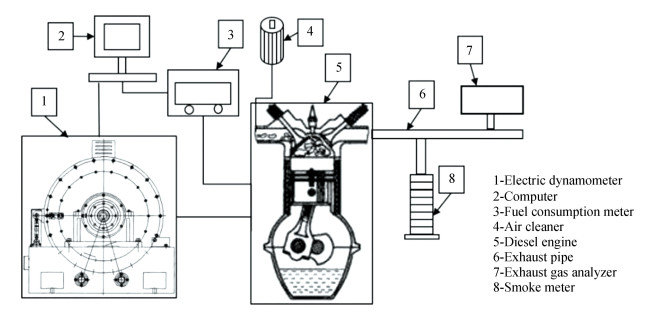
|
Fig.2 Experimental setup diagram |
3 Results and Discussion 3.1 Engine Power
Table 5 shows the output power of 186FA diesel engine. With the increase of methanol blending ratio, the engine output power is decreased. At rated condition, the output power of the engine fuelled with biodiesel, BM5, BM10 and BM15 is 5.55, 5.23, 4.76 and 4.14 kW; BM5, BM10 and BM15 is reduced by 5.77 %, 14.23 % and 25.41 % compared with biodiesel. Increasing DTBP proportion, the output power is gradually increased, or even higher than that of diesel. Since the injection quantity is unchanged and the methanol blending ratio is increased, the ignition of the blend is postponed. What is more, the addition of methanol reduces the heat release during the combustion process. Both the cetane number and LHV of methanol result in a decline in engine power. The blend with DTBP is easier to ignite, and accelerates the burning of the mixture in oil-rich and low temperature areas. On the other hand, good ignitability could shorten the ignition delay, advance the heat release, make the combustion process in a more effective range, and increase the output power of diesel engine.
| Table 5 Engine power of the fuels |
3.2 Economy
The LHV of methanol is only 54.1% of biodiesel, thus it is not proper to evaluate the engine economy by means of fuel consumption. In this paper, brake specific energy consumption (EBSEC) (MJ/(kW·h)) is used to evaluate the engine economy. EBSEC is calculated as formula (1):
| $ {E_{{\rm{BSEC }}}} = {b_{\rm{e}}} \times {H_{\rm{u}}}/1000 $ | (1) |
where be is brake fuel consumption (g/(kW·h)), Hu is the fuel LHV (MJ/kg).
Fig. 3 is EBSEC of the diesel engine at 3000 r/min. Fig. 2(a) shows that EBSEC of biodiesel and methanol/biodiesel is increased compared with diesel. At rated condition, EBSEC of biodiesel, BM5, BM10 and BM15 are 10.51, 10.86, 11.33 and 11.18 MJ/(kW·h), and BM5, BM10 and BM15 are increased by 3.31%, 7.78% and 6.37% compared with biodiesel. Increasing methanol blending ratio, EBSEC is increased. This is particularly evident at part loads. Firstly, the cylinder temperature at part loads is lower than that at full load. Secondly, methanol in the blend further reduces the in-cylinder temperature. The low temperature is not conducive to fuel combustion, resulting in the increase of EBSEC. Fig. 3(a) also shows that EBSEC of BM15 is a little lower than BM10. This is mainly due to the good atomization performance of methanol. Adding methanol in the blend fuel can improve the atomization effect. Uniform mixture increases the combustion efficiency and can improve the economy of the engine. Moreover, the ignition delay period of BM15 is longer than BM10, increasing the combustible mixture amount in the premixed combustion duration[32]. Thus, the constant volume combustion in the combustion cycle is enhanced, resulting in the reduction of EBSEC. Fig. 3(b) shows the effect of DTBP on engine EBSEC. With the increase of DTBP amount, the engine EBSEC is decreased gradually at part loads, but no obvious change is observed at full load. When working at a light load, the fuel quantity per cycle is smaller and with poorer atomization. DTBP improves the ignition of the fuel in partial poor-oil and low temperature areas, extending the combustion areas in the combustion chamber. Increasing engine load, the fuel quantity per cycle is increased and the combustion condition is better. So the effect of DTBP on improving ignition and combustion process is gradually weakened, resulting in less influence on EBSEC.
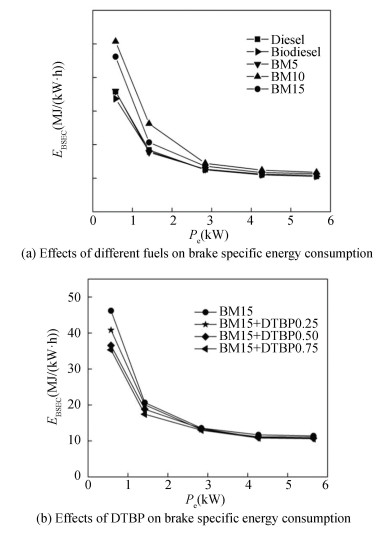
|
Fig.3 Variation of brake specific energy consumption with engine load |
3.3 Pollutant 3.3.1 NOx Concentration
Fig. 4 shows the NOx concentration. Fig. 4(a) indicates that the NOx concentration is significantly reduced with the addition of methanol. At rated condition, the NOx concentration of biodiesel, BM5, BM10 and BM15 is 691.71%, 657.02%, 457.56% and 544.79%, and BM5, BM10 and BM15 is reduced by 5.02%, 33.85% and 21.24% compared with biodiesel. While the NOx concentration of BM15 are increased a little compared with BM10, the experimental result can be explained from four aspects: 1) Due to the low boiling point of methanol, the addition of methanol improves the atomization of the blend and promotes the mixing of the fuel and air; 2) The addition of methanol effectively reduces the temperature in the cylinder at the end of the intake stroke, and narrows the high temperature combustion zone due to the high heat of vaporization, thus inhibiting the formation of NOx; 3) Methanol increases the oxygen concentration in the combustible mixture, and the fast burning speed of methanol promotes the formation of NOx; 4) Increasing methanol, the blend ignitability is deteriorated. The combustible mixture is reduced in the premixed combustion process and the in-cylinder temperature is reduced, conducive to the formation of NOx. When methanol is blended less than 10%, aspects 1) and 2) play a major role and the NOx concentration is reduced. When methanol is blended more than 10%, aspects 3) and 4) are the main reasons that promote the NOx formation. Fig. 4(b) shows the NOx concentration of the blend with DTBP. As DTBP can reduce the ignition delay period, the premixed duration is shortened, and the peak of in-cylinder pressure and temperature are both reduced. Therefore, increasing DTBP proportion, the NOx concentration is reduced.
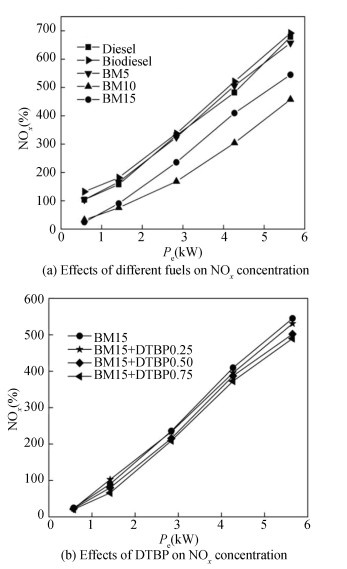
|
Fig.4 Variation of NOx concentration with engine load |
3.3.2 Smoke
Fig. 5 is the results of smoke. With the increase of methanol, the smoke is reduced gradually, and this trend is more obvious at heavy loads. Comparison of Figs. 4(a) and 5(a) leads to a conclusion that methanol changes the "trade-off" relationship between NOx and smoke of the diesel engine. At rated condition, the smoke of the diesel engine fuelled with biodiesel, BM5, BM10 and BM15 is 1.8, 1.7, 1.4 and 0.8, and BM5, BM10 and BM15 are reduced by 5.56%, 22% and 55.56% compared with biodiesel. Increasing DTBP proportion, the smoke is increased. Firstly, methanol improves the atomization of the blend. Secondly, there is no C-C bond in methanol molecules. Therefore, the aromatic hydrocarbon precursor of C2H2 and C3H3 is not easy to be produced in combustion process. Thirdly, in the high-temperature combustion stage, methanol can be decomposed into a large number of OH radicals. Ref. [42] shows that OH has much stronger ability to oxidize C2H2 (precursor of aromatic hydrocarbon) and soot than O and H. Methanol can easily produce a large number of OH radicals in pyrolysis. So the addition of methanol is not conducive to the formation of soot. On the other hand, the addition of DTBP can shorten the ignition delay period and the mixture formation time. This will be a small increase in soot.
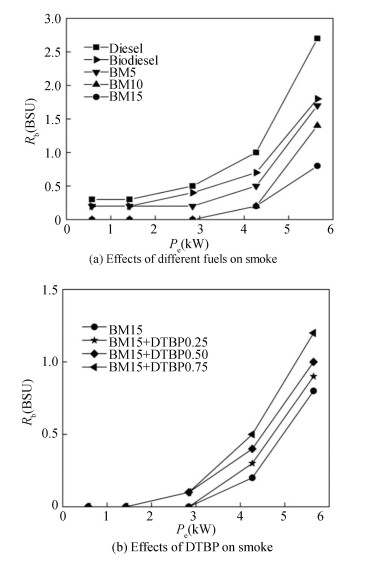
|
Fig.5 Variation of smoke with engine load |
3.3.3 CO concentration
CO is the product of incomplete combustion of fuel. CO can be oxidized to CO2 by OH radical in the combustion process. The chemical reaction formula is CO+OH↔CO2+H, and the oxidation rate KCO=6.67×1010 eT/1102[43]. Obviously, KCO shows that the oxidation ratio of CO is greatly influenced by temperature. When methanol is added to biodiesel, the maximum in-cylinder temperature is reduced, leading to the reduction of the oxidation rate of CO. That is the reason that methanol increases the CO concentration, as shown in Fig. 6(a). When 15% methanol is added, the CO concentration in the exhaust gas is slightly decreased. This may be due to the reason that the large mass of methanol extends the ignition delay period significantly, resulting in the increase of in-cylinder temperature and a large amount of mixture burned around the top dead center. Fig. 6(b) illustrates the CO concentration is reduced when DTBP proportion increases. DTBP improves the ignitability of the blend and shortens the ignition delay. The low temperature zone and poor-oil zone in the oil beam is reduced, promoting the CO oxidation.
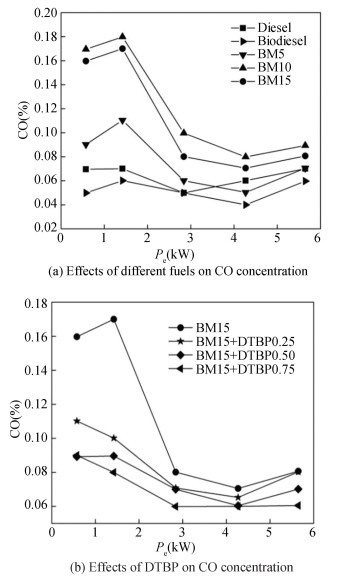
|
Fig.6 Variation of CO concentration with engine load |
3.3.4 HC concentration
Under anoxic conditions, the fuel combustion is incomplete and HC is easy to be produced.
With the addition of methanol, the temperature in the cylinder is lower, which aggravates the incomplete combustion of the fuel[44]. Fuel in this area is hard for perfect combustion and easy to form more HC. Fig. 7 shows the HC concentration. As can be seen, at the same load, the HC concentration of the engine using methanol/biodiesel engine is higher than biodiesel. When methanol proportion increases from 10% to 15%, the HC concentration is reduced a little. This is mainly due to the reason that the addition of methanol can extend ignition delay period. More combustible mixture is formed in the ignition delay period, and increasing the temperature in the cylinder narrows the area with low temperature. Therefore, less HC would be produced. The addition of DTBP leads to lower HC concentration.
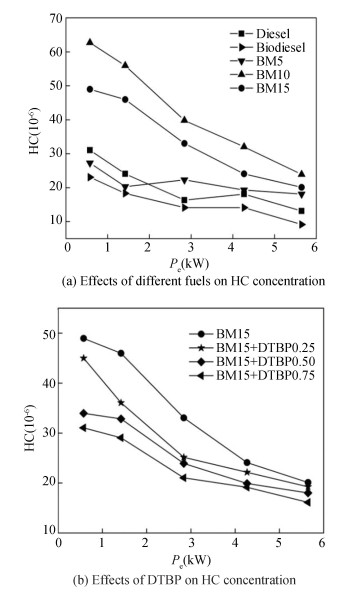
|
Fig.7 Variation of HC concentration with engine load |
The 186FA diesel engine bench test is conducted to analyze the output power, economy and emissions of diesel, biodiesel and methanol/biodiesel with or without DTBP. Based on the physical-chemical properties of the blend, the engine performance and pollutant show obvious difference when the diesel engine is fuelled with the fuels. According to the discussion on the diesel engine bench test above, the experimental result can be summarized as follows:
1) The addition of methanol reduces the engine output power. When the diesel engine is fuelled with BM15, the engine power is gradually increased with the increase of DTBP proportion.
2) The result of brake specific energy consumption shows that when methanol blending ratio increases, the EBSEC increases, especially at part loads. The addition of DTBP could reduce the EBSEC of the engine at part loads, but has little influence at full load.
3) Using methanol can reduce NOx and smoke significantly, but increase the CO and HC concentration. Compared with BM10, the NOx concentration of BM15 is slightly increased, but CO and HC concentration is reduced.
4) The addition of DTBP reduces NOx, CO and HC, but the increase of smoke is little.
4 Conclusions1) Energy shortage and environmental pollution is serious in China. Methanol and biodiesel have wide range of raw materials and can be miscible easily. Methanol/biodiesel blend is in line with China's actual condition of carbon peak and carbon neutralization, and can be easily applied in small diesel engine. So the methanol/biodiesel blend can be a good choice of alternative fuel for Chinese small agricultural diesel engine.
2) The density, viscosity, cetane number and some other physical-chemical properties of methanol and biodiesel could be complementary. When a small proportion methanol is in methanol/biodiesel blend, the blend can be used directly in diesel engine. When a large proportion of methanol is used, a cetane number improver is needed to improve the ignitability of the blend.
3) Compared with biodiesel, the engine power is significantly reduced and the specific energy consumption rises when methanol/biodiesel is used. When methanol blending ratio reaches 10% and 15%, the power drops down to 14.23% and 25.41% compared with biodiesel. When DTBP is added in BM15, the engine power is increased or even exceeds that of diesel. The emission results show that, compared with biodiesel, the addition of methanol significantly reduces the NOx concentration and exhaust smoke, while the CO and HC concentration increases slightly. When 15% methanol is blended to biodiesel, the NOx concentration is increased and the CO, HC concentration are reduced compared with 10% methanol. DTBP in BM15 reduces the NOx, CO and HC concentration, but increases the smoke a little.
4) According to the test results, DTBP can effectively improve the ignition performance of the fuel, but whether there is a better cetane number improver needs further experimental research. Moreover, the effect of cetane number improver needs to be explained based on chemical reaction kinetics, which is also the research work that can be carried out in the future.
| [1] |
National Bureau of Statistics. The Production of Tractors in China. http://www.stats.gov.cn/.
(  0) 0) |
| [2] |
Burtscher H. Physical characterization of particulate emissions from diesel engines: a review. Journal of Aerosol Science, 2005, 36(7): 896-932. DOI:10.1016/j.jaerosci.2004.12.001 (  0) 0) |
| [3] |
China Commercial Industry Research Institute. The State of China's Mineral Resources Was Officially Announced, and the Proved Reserves of China's Coal Resources Increased Steadily. https://www.niumoney.com/news/notice_101820.html.
(  0) 0) |
| [4] |
Li Q J, Shen T H, Meng Z H, et al. Methonal production by coal clean reforming is the optimum option for China to replace oil energy. China Foreign Energy, 2006, 11(4): 1-8. (in Chinese) (  0) 0) |
| [5] |
Cheng C H, Cheung C S, Chan T L, et al. Comparison of emissions of a direct injection diesel engine operating on biodiesel with emulsified and fumigated methanol. Fuel, 2008, 87(10-11): 1870-1879. DOI:10.1016/j.fuel.2008.01.002 (  0) 0) |
| [6] |
Zhang Z H, Tsang K S, Cheung C S, et al. Effect of fumigation methanol and ethanol on the gaseous and particulate emissions of a direct-injection diesel engine. Atmospheric Environment, 2011, 45(11): 2001-2008. DOI:10.1016/j.atmosenv.2010.12.019 (  0) 0) |
| [7] |
Karabektas M, Ergen G, Hosoz M. Effects of the blends containing low ratios of alternative fuels on the performance and emission characteristics of a diesel engine. Fuel, 2013, 112: 537-541. DOI:10.1016/j.fuel.2011.04.036 (  0) 0) |
| [8] |
Wang Z, Xu G J, Huang H L, et al. Reliability test of diesel engine fueled with biodiesel. Transactions of the CSAE, 2009, 25(11): 169-172. DOI:10.3969/j.issn.1002-6819.2009.11.030 (  0) 0) |
| [9] |
Özener O, Yüksek L, Ergenç A T, et al. Effects of soybean biodiesel on a DI diesel engine performance, emission and combustion characteristics. Fuel, 2014, 115: 875-883. DOI:10.1016/j.fuel.2012.10.081 (  0) 0) |
| [10] |
Sathiyamoorthi R, Sankaranarayanan G, Kumaar S B, et al. Experimental investigation on performance, combustion and emission characteristics of a single cylinder diesel engine fuelled by biodiesel derived from Cymbopogon Martinii. Renewable Energy, 2019, 132(MAR): 394-415. DOI:10.1016/j.renene.2018.08.001 (  0) 0) |
| [11] |
Sathiyamoorthi R, Sankaranarayanan G, Pitchandi K. Combined effect of nanoemulsion and EGR on combustion and emission characteristics of neat lemongrass oil (LGO)-DEE-diesel blend fuelled diesel engine. Applied Thermal Engineering, 2017, 112: 1421-1432. DOI:10.1016/j.applthermaleng.2016.10.179 (  0) 0) |
| [12] |
Sathiyamoorthi R, Sankaranarayanan G. Effect of antioxidant additives on the performance and emission characteristics of a DICI engine using neat lemongrass oil-diesel blend. Fuel, 2016, 174: 89-96. DOI:10.1016/j.fuel.2016.01.076 (  0) 0) |
| [13] |
Wang X, Ge Y S, Yu L X, et al. Comparison of combustion characteristics and brake thermal efficiency of a heavy-duty diesel engine fueled with diesel and biodiesel at high altitude. Fuel, 2013, 107: 852-858. DOI:10.1016/j.fuel.2013.01.060 (  0) 0) |
| [14] |
Li R N, Wang Z, Liu S. Study on the structure characteristics of diesel engine particulates based on small-angle X-ray scattering. Environmental Progress & Sustainable Energy, 2019, 38(5): 13175. DOI:10.1002/ep.13175 (  0) 0) |
| [15] |
Li R N, Wang Z, Tang C Y, et al. Study on particulate structure characteristics of diesel engines fueled with a methanol/biodiesel blend. ACS Omega, 2021, 6(9): 6081-6087. DOI:10.1021/acsomega.0c04371 (  0) 0) |
| [16] |
Huang Z H, Lu H B, Jiang D M, et al. Combustion behaviors of a compression-ignition engine fuelled with diesel/methanol blends under various fuel delivery advance angles. Bioresource Technology, 2004, 95(3): 331-341. DOI:10.1016/j.biortech.2004.02.018 (  0) 0) |
| [17] |
Qi D H, Chen H, Geng L M, et al. Performance and combustion characteristics of biodiesel-diesel-methanol blend fuelled engine. Applied Energy, 2010, 87(5): 1679-1686. DOI:10.1016/j.apenergy.2009.10.016 (  0) 0) |
| [18] |
Wang Z, Li R C, Zhang D P, et al. Combustion process analysis of methanol/diesel dual fuel engine. Transactions of the Chinese Society of Agricultural Engineering, 2013, 29(8): 78-83. DOI:10.3969/j.issn.1002-6819.2013.08.009 (  0) 0) |
| [19] |
Zhang Z H, Cheung C S, Chan T L, et al. Experimental investigation of regulated and unregulated emissions from a diesel engine fueled with Euro V diesel fuel and fumigation methanol. Atmospheric Environment, 2010, 44: 1054-1061. DOI:10.1016/j.atmosenv.2009.12.017 (  0) 0) |
| [20] |
Zhang Z H, Cheung C S, Yao C D. Influence of fumigation methanol on the combustion and particulate emissions of a diesel engine. Fuel, 2013, 111: 442-448. DOI:10.1016/j.fuel.2013.05.014 (  0) 0) |
| [21] |
Venu H, Madhavan V. Influence of diethyl ether (DEE) addition in ethanol-biodiesel-diesel (EBD) and methanol-biodiesel-diesel (MBD) blends in a diesel engine. Fuel, 2017, 189: 377-390. DOI:10.1016/j.fuel.2016.10.101 (  0) 0) |
| [22] |
Karthick M, Ganesan S, Raja T. Study on emission characteristics of a methanol-biodiesel blends fuelled diesel engine. International Journal of Ambient Energy, 2021, 42(3): 314-318. DOI:10.1080/01430750.2018.1550014 (  0) 0) |
| [23] |
Žaglinskis J, Lukács K, Bereczky Á. Comparison of properties of a compression ignition engine operating on diesel-biodiesel blend with methanol additive. Fuel, 2016, 170: 245-253. DOI:10.1016/j.fuel.2015.12.030 (  0) 0) |
| [24] |
Li R N, Wang Z, Ni P Y, et al. Effects of cetane number improvers on the performance of diesel engine fuelled with methanol/biodiesel blend. Fuel, 2014, 128: 180-187. DOI:10.1016/j.fuel.2014.03.011 (  0) 0) |
| [25] |
Bayraktar H. An experimental study on the performance parameters of an experimental CI engine fueled with diesel-methanol-dodecanol blends. Fuel, 2008, 87(2): 158-164. DOI:10.1016/j.fuel.2007.04.021 (  0) 0) |
| [26] |
Li R N, Wang Z, Li M D, et al. The improved estimated method of esters fuel cetane number. Acta Petrolei Sinica (Petroleum Processing Section), 2013, 29(5): 899-904. DOI:10.3969/j.issn.1001-8719.2013.05.025 (  0) 0) |
| [27] |
Yao C D, Dai Q, Xu H J, et al. Ignition and combustion characteristics of diesel spray in premixed methanol/air mixture with high temperature. Journal of Combustion Science and Technology, 2012, 18(4): 193-198. (  0) 0) |
| [28] |
Wang L J, Song R Z, Zou H B, et al. Orthogonal test on intake methanol ratio of methanol/diesel dual fuel engine. Journla of Xi'an Jiaotong University, 2007, 41(1): 1284-1287. (  0) 0) |
| [29] |
Popa M, Negurescu N, Pana C. Results obtained by methanol fuelling diesel engine. Proceedings of the 2001 Environmental Sustainability Conference and Exhibition-P-365, Alternative Diesel Fuels-PT-111. Warrendale, PA: SAE, 2001. DOI: 10.4271/2001-01-3748.
(  0) 0) |
| [30] |
Xu H J, Yao C D, Xu G L. A skeletal chemical kinetic model containing 23 reactions for the ignition of N-deptane/methanol dual fuel. Transactions of CSICE, 2001, 29: 391-397. (  0) 0) |
| [31] |
İçıngür Y, Altiparmak D. Effect of fuel cetane number and injection pressure on a DI Diesel engine performance and emissions. Energy Conversion and Management, 2003, 44(3): 389-397. DOI:10.1016/S0196-8904(02)00063-8 (  0) 0) |
| [32] |
Zhang J Q, Lu H B, Wang X B, et al. Combustion and emission characteristics of a DI diesel engine fueled by diese-l methanol blends. Journal of Combustion Science and Technology, 2004, 10(2): 171-175. (  0) 0) |
| [33] |
Ramalingam S, Sankaranarayanan G, Munuswamy D B, et al. Experimental Study of Spray Analysis for Palmarosa Biodiesel 〥 Iesel Blends in a Constant Volume Chamber (CVC). https://aiche.onlinelibrary.wiley.com/doi/epdf/10.1002/ep.13696, 2021-09-09. DOI:10.1002/ep.13696.
(  0) 0) |
| [34] |
Sathiyamoorthi R, Sankaranarayanan G, Venkatraman M, et al. Environment-Friendly Fuel Cymbopogon Flexuosus: Analysis of Fuel Properties, Performance, and Emission Parameters of a Direct Injection Compression Ignition Research Engine. https://onlinelibrary.wiley.com/doi/epdf/10.1002/htj.22194, 2021-09-09.
(  0) 0) |
| [35] |
Gong C M, Wang S, Liu J J, et al. Effect of ambient temperature on cold start behavior of S. I. methanol engine. Journal of Jilin University (Engineering and Technology Edition), 2009, 39(1): 27-32. DOI:10.13229/j.cnki.jdxbgxb2009.01.024 (  0) 0) |
| [36] |
He X L, Zhan Y H, Li S S. Fuel of Internal Combustion Engine. Beijing: China Petrochemical Press, 2004, 436. (  0) 0) |
| [37] |
Wang L J, Zou H B, Song R Z, et al. Effect of pilot fuel quantity on combustion characteristics of a methanol-diesel dual fuel engine. Journal of Xi'an Jiaotong University, 2007, 41(1): 517-542. (  0) 0) |
| [38] |
Yao C D, Wang Y S, Li Y Q, et al. Study on clean burning methanol in diesel engines. Transactions of the Chinese Society for Agricultural Machinery, 2005, 36(5): 24-27. (  0) 0) |
| [39] |
Yasin M H M, Yusaf T, Mamat R. Characterization of a diesel engine operating with a small proportion of methanol as a fuel additive in biodiesel blend. Applied Energy, 2014, 114: 865-873. DOI:10.1016/j.apenergy.2013.06.012 (  0) 0) |
| [40] |
Lü X C, Zhang W G, Yang J G, et al. Effect of cetane number improver on heat release rate and emissions of high speed diesel engine fueled with ethanol diesel blend fuel. Journal of Combustion Science and Technology, 2005, 11(1): 56-61. (  0) 0) |
| [41] |
Wang Z, Qu L, Li M D, et al. Effect of DTBP on biodiesel combustion and emission characteristics of engine fuelled with bio-diesel. Transactions of the Chinese Society of Agricultural Engineering, 2012, 28(23): 60-66. DOI:10.3969/j.issn.1002-6819.2012.23.009 (  0) 0) |
| [42] |
Schmidt K, van Gerpen J. The effect of biodiesel fuel composition on diesel combustion and emissions. Alternative fuel: composition, performance, engines, and systems-S-1181. Warrendale, PA: SAE, 1996. DOI: 10.4271/961086.
(  0) 0) |
| [43] |
Yan Y, Zhang Y S. Methanol reduced mechanism and its application in HCCI combustion analysis. Journal of Huazhong University of Science & Technology (Natural Science Edition), 2010, 38(9): 112-115. (  0) 0) |
| [44] |
Cheung C S, Zhu L, Huang Z. Regulated and unregulated emissions from a diesel engine fueled with biodiesel and biodiesel blended with methanol. Atmospheric Environment, 2009, 43(32): 4865-4872. DOI:10.1016/j.atmosenv.2009.07.021 (  0) 0) |
 2022, Vol. 29
2022, Vol. 29


